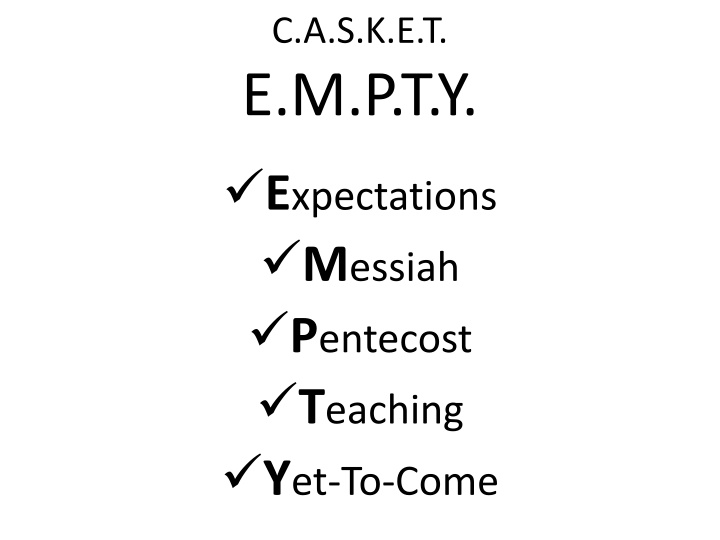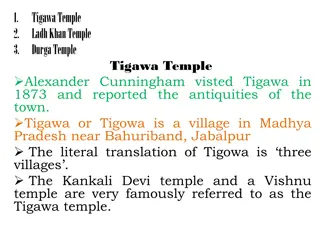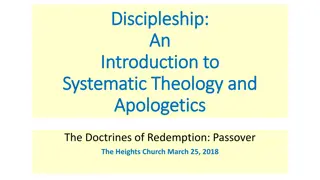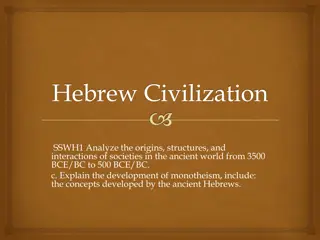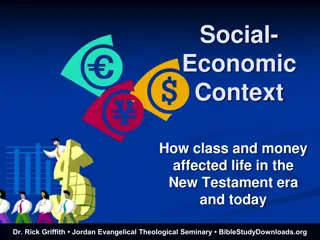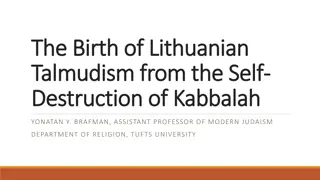Insights into the Intertestamental Period and Second Temple Judaism
Explore the significance of the Intertestamental Period and the evolution of Second Temple Judaism through major events, empires, and key figures such as the Persians, Greeks, Hasmoneans, and Romans. Uncover the historical context surrounding this pivotal era that laid the groundwork for the transition between the Old and New Testaments.
Download Presentation

Please find below an Image/Link to download the presentation.
The content on the website is provided AS IS for your information and personal use only. It may not be sold, licensed, or shared on other websites without obtaining consent from the author.If you encounter any issues during the download, it is possible that the publisher has removed the file from their server.
You are allowed to download the files provided on this website for personal or commercial use, subject to the condition that they are used lawfully. All files are the property of their respective owners.
The content on the website is provided AS IS for your information and personal use only. It may not be sold, licensed, or shared on other websites without obtaining consent from the author.
E N D
Presentation Transcript
C.A.S.K.E.T. E.M.P.T.Y. Expectations Messiah Pentecost Teaching Yet-To-Come
EXPECTATIONS - The Intertestamental Period OT NT Between the Testaments
Why does the Intertestamental Period Matter??? God s Promises Fulfilled Ex. Book of Daniel History of Our People Background of New Testament Writings Samaritans Pharisees Saduccees Tax Collectors and Zealots Adoption Salvation Epicureans and Stoics ETC., ETC., ETC.
Major Periods within Second Temple Judaism Second Temple Judaism developed as political authority changed hands from the Persians to the Greeks, to the Jewish Hasmoneans, and finally to the Romans. 539 331 B.C. 331 164 B.C. The Hellenistic Period 164 63 B.C. 63 B.C. A.D. 70 Ptolemaic (Egyptian) Period (320 198) The Hasmonean (Maccabean) Period The Persian Period The Roman Period Seleucid (Syrian) Period (198 164)
Chapter 2 Chapter 7 Chapter 8 Interpretation Head of Gold Lion Babylon deported Judah s king in 605 Chest and Arms of Silver Bear Ram Medo-Persian Empire defeated Babylon in 539 BC Belly and Thighs of Bronze Leopard Goat (North/South in chapter 11) Greece defeats Persians in 331 BC Prolemies and Seleucids Legs of Iron Terrifying Beast Rome assimilated former Greek holdings Rock Against Feet of Clay Son of Man Kingdom of God
The Persian Post-Exilic Period 539-332 B.C. Aramaic Possibly synagogue (no temple or sacrifice) Book of Daniel Chest and Arms of Silver Bear Ram
The Hellenistic Period 332 63 B.C. Alexander the Great of Macedon (356 323) Aristotle was his tutor Cutting the Gordian Knot Defeated Persian Empire Book of Daniel Belt and Thighs of Bronze Leopard Goat
The Hellenistic Period 332 63 B.C. Ptolemaic (Egypt) 320 - 198 B.C. Dynasty began in 323 Alexander s General Ptolemy I Soter (savior) Alexandria (capital) Judah under their rule till 198 B.C. Ptolemy I Soter (savior) Greek translation of the Hebrew Scriptures (Old Testament) Among Greek-speaking Jews this Bible became a standard text, serving both Judaism and the early church for centuries. Burge, Cohick and Green
Hellenistic Period 332 63 B.C. Seleucid (Syria) 198 - 167 B.C. Dynasty began in 313 Alexander s General Seleucus I Nicator (conqueror) Antioch capital Acts 11:19-20 Rule obtained from Ptolemies in 198 Antiochus IV Epiphanes (manifestation, i.e., the revealing of God on earth) Sought worship Frustrated with the Jewish people he turned the temple over to the worship of Zeus and for three years pigs were sacrificed by Greeks on Israel s holy altar. Burge, Cohick, Green
Israel Under the Maccabees
Maccabean War 167 141 B.C. Hassidim (pious ones) passively revolted against Antiochus Epiphanes Open Warfare Matathias and his sons Judas, Simon and Jonathan Launched guerrilla campaign to expel Greeks from the land Matathias killed so Judas led war gaining the nickname Maccabeus (hammer) 164 Judas gained the temple precincts and cleansed th sanctuary, inaugurating the feast we know as Hanukkah also referred to as the festival of lights
The Hasmonean Dynasty 141 63 B.C. The family of Mattathias and heirs In a generation Judaism found itself torn in three ways: Hellenized Jews Hasmoneans had power in Jerusalem The Saduccees in the temple AND High Priestly Turban represents the Sadduccees
The Hasmonean Dynasty 141 63 B.C. Hasidim (pious ones) who called for religious purity and warned of the corruptive dangers of power The Pharisees: lay movement Synagogues Precision in study and application of Scripture Zealots: radical religious sect seeking to overthrow Roman rule through violence. (Luke 6:15)
The Roman Period begins 63 B.C. Pompey s Conquest (63 B.C.) Freed the Decapolis (League of Ten Cities) region promising they would never have to live under Jewish rule again Mark 5:1-20 When Jesus entered he went into a strictly Greek world, hence the presence of pigs Conquered Jerusalem and entered Most Holy Place Book of Daniel Legs of Iron Terrifying Beast First Roman Emperor Caesar Augustus Coins have Latin inscription DIVI FILIUS of the divine one, the son.
Roman Emperors (31 b.c.a.d. 68) Augustus 31 B.C. A.D. 14 Tiberius A.D. 14 37 Gaius Caligula A.D. 37 41 Claudius A.D. 41 54 Nero A.D. 54 68
